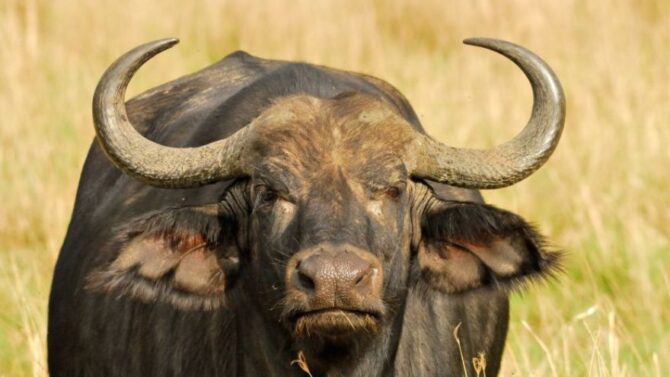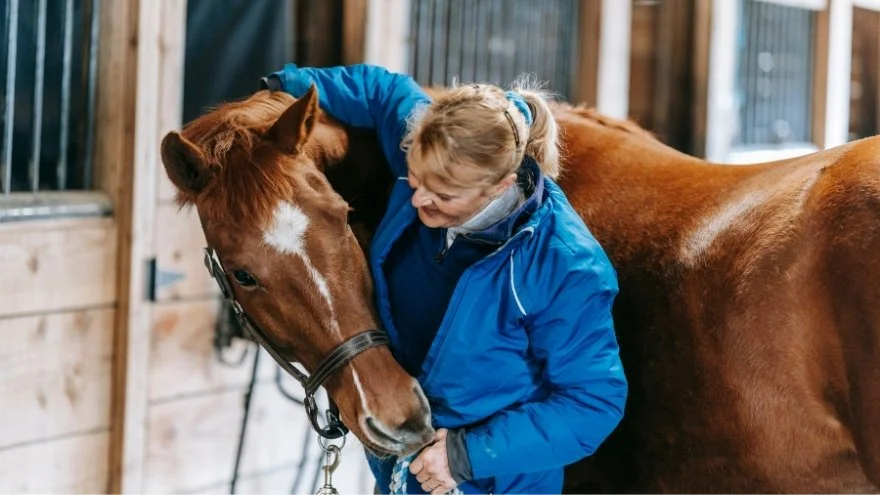The horse is a member of the Equidae family, a well-known mammal seen at ranches and in western movies. It is a one-toed, hoofed animal that was successfully domesticated years back.
Over 50 million years ago, the evolutionary theory states that this animal had multiple toes. It has since evolved to what we know now.
There are still feral, uncontrolled exceptions, but the majority have contributed immensely to human activities like farming and racing.
None can also deny the positive impact horses have had on human civilization from old times, and to date, they are much loved.
Scientific Classification
| Kingdom | Animalia |
| Phylum | Chordata |
| Class | Mammalia |
| Order | Perissodactyla |
| Family | Equidae |
| Genus | Equus |
| Species | E. ferus |
| Subspecies | E.f Caballus |
| Trinomial Name | Equus ferus caballus |
Characteristics
| Height | 1.4 to 1.7m |
| Weight | 840 to 1,200 pounds |
| Venom/Poison | No |
| Skin Type | Hair |
| Habitat | Forests, grasslands |
| Range | Worldwide |
| Diet | Herbivore |
| Life span | 25 to 30 years |
| Gestation Period | 11 to 12 months |
| Conservation status | Domesticated |
5 Interesting Facts About Horse
1. They were a core part of human civilization
Horses have been used for leisure activities, work, sports, and modes of transportation.
In these ways, they have contributed to the growth of humanity and the progression of history from then to now.
They were also used by generals to go to war, another contribution they’ve brought to humanity.
Their work hasn’t ended in modern times. Though no longer used as transport in many places and as companions of war, they still work, participate in sports, are kept as pets, and are used for leisure.
2. Horses have big eyes and can’t breathe through the mouth
Two physical traits that are peculiar to horses concern both the eyes and the mouth.
Horses have big eyes, and these eyes are considered the biggest amongst living land animals.
This is because they are prey, and the eyes serve to help them detect a threat with ease.
They can’t breathe through their mouth the way humans do. These animals are termed “obligate nose breathers” because they breathe only with the nose.
They can’t burp either. The mouth also houses its teeth, and you can estimate a horse’s age by its teeth.
3. They sleep standing up
This may not come as a surprise to many people, but the idea that these animals can only lie down to sleep is still prevalent in the minds of a few.
While it is possible for them to sleep lying down, they don’t always adopt that position.
They can comfortably sleep standing, and the amazing part is how they achieve this.
The horse muscles have a special arrangement of muscular parts called the stay apparatus, which enables them to stand on three legs while resting on one.
They switch the resting leg at intervals to enable all legs to rest.
4. Horses have a long lifespan
Horses live long compared to many other mammals, and their life expectancy goes up to 30 years.
Some can even live longer than that. The longevity can be traced to advances in horse medicine and horse care.
That said, some factors can affect the lifespan. Injuries, illness, attacks from predators, and work stress can cut off life.
The breed type is another factor that can affect horse longevity, as well as its environment. Wild horses live shorter.
5. Horses were domesticated around 3500 B.C.
Compared to animals like dogs and cats, the domestication of horses is more recent.
It possibly began in central Asia close to 3500 B.C. Archaeology and some other fields seem to confirm this, as the earliest evidence points towards 4,000 to 3,500 B.C.
General Description
Horses look similar to animals like zebras and donkeys, which is to be expected as they are all equines.
Individuals don’t look the same because of breed differences, but there are many similarities among them.
They have large heads, long necks, large eyes, and long ears. All these help in survival.
Every horse has a mane that goes down to the neck, as well as a hairy tail that can swish back and forth.
The color depends on the breed, and it includes black, brown, or white. Some breeds have a mixture of colors.
The hoof color is usually black, but white horses come with white colors.
Unlike other animals, this creature’s height is measured with a hand in place of inches. There were no measuring instruments in older times, so people resorted to using their hands. The practice has lasted till today.
Another trait is the single toe at the end of the hooves. It is believed that they once had two toes, but evolution turned these toes into just one.
Distribution and Habitat
As domesticated animals, horses can be found on every continent except Antarctica.
Feral ones also have a wide range. Overall, it is rare to meet someone who has never seen this animal before.
Just like domestic dogs and many other creatures that are kept amongst humans, horses can adapt to different environments.
What the domestic pet need is shelter, feeding, and enough space.
With all those in place, you wouldn’t have a problem getting your riding pal to cope with any habitat. Wild ones can be found in plains, forests, and grasslands.
Horse Diet
Horses are strictly herbivores, and there’s no sign of meat in their diet. Every nutrient they get is plant-based.
This doesn’t mean they are constrained to a limited diet. They can get all they need from plants, and a good owner will ensure they get rich nutrients.
These animals eat a lot of vegetation, especially grass. The grass is the most common meal as it is readily available, especially during summer.
They can also eat hay when grass may be scarce such as during winter.
Then there are vegetables and fruits like apples and carrots which owners can use to add variety to the diet. Salt in the form of a block is another good meal.
Reproduction and Mating Process
Domestic horses are often bred artificially to select the best qualities for the next generation. Artificial selection is the reason for a variety of colors, sizes, and breeds.
Natural, unpredictable breeding hardly occur amongst these folks. Wild ones reproduce naturally, and they are known to be polygamous.
A male (known as a stallion) herds a group of females (called mares) and mates with them.
Like other mammals, the mare gives birth to live rather than laying eggs. She carries the young ones for 11 months, after which she gives birth.
The young one is termed a foal till it gets weaned. After only a while, the foal starts walking and running.
The weaned male is called a colt and the female, a willy. The foal gets ready to mate a month after weaning.
Predators and Threats
The horse is prey, and all its features are meant to help it escape potential predators.
Its long ears and large eyes pick up any threat from a distance, and it has speed.
These animals also protect themselves by kicking and biting. Feral horses are more at risk of predators than their domestic counterparts.
Predators of these mammals include large cats, wolves, bears, alligators, and boars. These predators tend to go after sick or injured individuals as the latter are less likely to defend themselves.
Humans don’t pose much threat as we need these able workers, but feral ones are sometimes hunted down or held captive. They are also threatened by habitat loss.
Horse Behavior
Horses have sharpened vision, smell, and hearing. However, they tend to rely more on their vision than on their smell and hearing.
Their eyes are placed on the sides as is expected with prey. As an owner, you should approach it from the sides and not the front. Their senses are better than that of humans, and they have night vision.
Horses have a strong fight-or-flight instinct, and they tend to choose the latter over the former.
However, when a foal is involved, you can count on the mare to deliver some kicks.
These animals are social, and you’d often find them living in a herd except if you meet a domestic pet.
They prefer living in a group, and contrary to what people used to think there is no order of dominance amongst these guys. They thrive a lot on positive reinforcements.
There tends to be a good bond between humans and these animals. With their intelligence, it is easy to establish this bond.
The bond is very important for workers, pets, and sports animals. There should be a human-pet form of communication.
The pet horse doesn’t see the owner as a member of the herd like domestic dogs do with their parents.
However, in the absence of other horses, the owner is all it knows. It could experience separation anxiety when you’re not around. Signs of separation anxiety in this animal include:
- Pancing and jogging
- Sweating
- Neighing consistently
- Loss of appetite
- Confusion and trembling
Fortunately, there are functional ways to ease off separation anxiety.
Male vs Female
All mammals have a male and female gender, and this includes our subject.
Males here are further divided into two categories: the stallion and the gelding. The stallion is a male that can reproduce.
The gelding is a castrated male. Geldings and mares are generally easier to handle.
The first difference between the genders is in size. Males tend to be bigger than females, but the big difference lies in their behavior.
Males are stronger and faster but are usually more aggressive. Females are easier to train, more grounded, and docile.
The choice of gender mainly depends on what you need it for, as well as your personal preference.
There are pros and cons associated with owning a mare, stallion, or gelding.
Frequently Asked Questions
What is the difference between a zebra and a horse?
Horses and zebra look alike, but they are different. The former is bigger and faster, having a better ability to carry a load. Also, zebras have not been domesticated, regardless of their attempts.
Are horses dangerous?
Feral individuals are highly dangerous, especially if it sees you as a threat. Domestic horses can also be dangerous when they panic, especially if you’re riding. Always be on the lookout for anything that can trigger panic. Do not start directly behind the legs, as a kick has been known to kill people.
Do horses like to be pets?
Horses can make good pets and don’t seem to mind, but like dogs, each individual has a different personality. Learn how best to treat your pet.
How do I ride a horse?
Riding is a step-by-step process that starts with learning how to mount. If you’re a beginner, do not rush the process. You would need to learn how to position, hold the reins, and some other riding basics.
Wrap Up
Domesticating this animal turned out to be a good decision because of its multiple impacts on human development.
It remains a good worker, pet, and participant in different sports. With there being so many of them around, humanity will benefit from these animals for a long.


